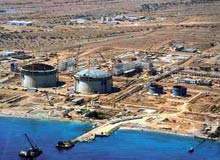
The Oman Liquid Natural Gas (LNG) project involved the construction of a $6.6 million tonnes per year LPG processing plant at Qalhat near Sur, located in Central Oman. This is about 230 kilometres south east of Muscat.
In January 2002, Oman LNG was granted another $1.3 billion loan from a consortium of banks. This was done to refinance the original debt for the industrial plant. The upstream part of the project is wholly owned by the Government, but is operated by Petroleum Development Oman, which has responsibility for field appraisal and development, gas processing and transport by pipeline to the liquefaction plant at Qalhat near Sur.
PLANT PRODUCTION & COST
The initial cost of the LPG project was about $2.5 billion. This involved installing pumping stations and pipelines, constructing the LNG plant, roads, supporting infrastructure, a port to off-load the LNG, a desalination plant to provide water, and storage facilities.
The construction of the liquefication plant was the largest single industrial construction project ever undertaken in Oman. The lead contract for the plant was given to a consortium led by Foster Wheeler, an experienced participant in the business. The consortium also involved the Japanese Chiyoda, and two local companies: the SSB and Zubair groups.
Snamprogetti and Bechtel won an award for upstream work on the 400km in pipelines from central gas fields in Saih Rawl, Barik, and Saih Nihayda to Qalhat, and the central fields’ collection plant. General Electric and Stone and Webster won the contract for construction of an upstream power plant.
LPG GAS EXPORT
The supplies of non-associated gas for the project were first discovered in the Omani interior in 1989. The resource far outstripped local demand, and therefore the government of Oman became interested in the possibility of exporting the gas as LPG. This was part of an overall drive to move the Omani economy away from dependence on direct oil production. This drive is a result of the fluctuations in oil price, which have caused difficulties for the economy of Oman as well as for other economies in the region. The project therefore involves an element of technology transfer as well as a strong measure of local employment. The company has also taken part in social investment, notably a new hospital. Gas reserves in Oman are currently standing at about 25 trillion cubic feet, and forecast to rise to about 40 trillion cubic feet by the year 2015, so the future feedstock of the plant seems assured.
SUPPLY CONTRACTS
In October 1996, Oman LNG signed a sale and purchase agreement with Korea Gas Corporation to supply liquefied natural gas for 25 years starting in April 2000. Also, an agreement for Osaka Gas of Japan to buy 0.7 million tons per year for 25 years was successfully completed, when a full sale and purchase agreement was signed in October 1998. The first shipment was sent to South Korea in April 2001. A sale and purchase deal was made with India’s Dabhol Power Company as well. Under this agreement, 1.6 million tons per year will be sold to the company for a period of 20 years.
LNG COMPANY
This LNG company is a joint venture consisting of the Omani Government (51%), Shell (30%), Total (5.54%), KOLNG (5%), Mitsubishi (2.77%), Mitsui (2.77%), Partex (2%) and Itochu (0.92%). The Oman LNG project was financed by 41 international and Omani banks backed up by export credit agencies from the United States, United Kingdom, Netherlands and Italy. The LNG company is reported to believe that it will break even during 2000, and pay dividends in 2001.

